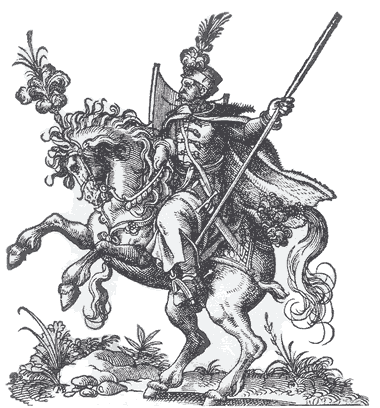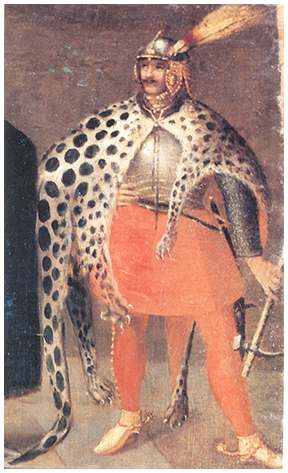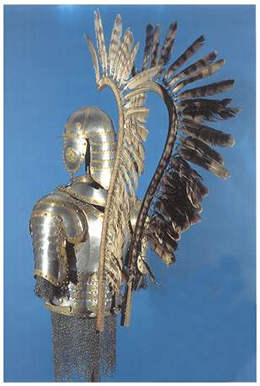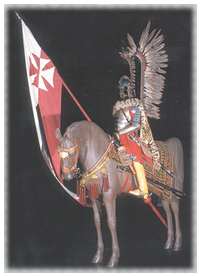|

Introduction
Hetman
Commanders
Battle
Tactics (17thC)
Army
Sizes
'Cossack'
Cavalry
Hussar
Cavalry
|
|
The Hussars
 These
were the elite of the Polish army being a unique, highly trained,
manoeuvrable, hard-hitting, heavy cavalry. The hussars used tactics
of speed and manoeuvrability, especially in the charge which was
carried out at a full gallop in tight, knee-to-knee formations. These
were the elite of the Polish army being a unique, highly trained,
manoeuvrable, hard-hitting, heavy cavalry. The hussars used tactics
of speed and manoeuvrability, especially in the charge which was
carried out at a full gallop in tight, knee-to-knee formations.
The hussars predecessors
appeared in Poland at around the turn of the 16th Century, they
were Serbian and Hungarian mercenaries known as 'raclowice' or 'usaria'
(usars). They wore no armour and were armed with lance, sabre and
shield. Present at the battle of Kleck (1506) they showed their
worth against the elusive tartars and because of their success,
compared to the lumbering heavy knights, many Polish noblemen followed
suite fighting like the usars. Their number slowly increased, at
the battle of Orsza (1514) there were large numbers of lance armed
light cavalry and 800 hussars formed a sizable part of the reserve.
 During
the first half of the 16th century they began to replace the knight
as the main striking arm of the Polish field army and at the same
time they began to wear armour. By the Livonian war (1557-70) there
were twice as many hussars as knights. They were equiped with a
mail coat, helmet, shield, lance and sabre, while a significant
proportion wore breastplates. During
the first half of the 16th century they began to replace the knight
as the main striking arm of the Polish field army and at the same
time they began to wear armour. By the Livonian war (1557-70) there
were twice as many hussars as knights. They were equiped with a
mail coat, helmet, shield, lance and sabre, while a significant
proportion wore breastplates.
However though they
gained armour they did not become extra-heavy cavalry. It was King
Stefan Batory who ensured they remained a fast heavy cavalry and
did not get slowed down by excess weight. He also introduced a much
higher level of training, as well as higher pay than the cossack
cavalry and benefits for those serving for longer periods.
 In
Batory's time the hussars usually dressed in Hungarian style in
Zupan (Joupane) coats (traditional nobleman's coats), long red trousers
and short yellow boots. For decoration they wore wild animal skins,
preferably tiger or leopard, but when these were in short supply
wolf and lynx skins were worn or embroidered eastern style capes
called 'kilimki'. In
Batory's time the hussars usually dressed in Hungarian style in
Zupan (Joupane) coats (traditional nobleman's coats), long red trousers
and short yellow boots. For decoration they wore wild animal skins,
preferably tiger or leopard, but when these were in short supply
wolf and lynx skins were worn or embroidered eastern style capes
called 'kilimki'.
Hussar's
arms, armour and equipment was highly specialised and well suited
to their requirements. Arms and armour was provided by each hussar,
except the lances which were provided by the king via the 'rotmistrz'.
The men were individually well skilled in horsemanship and the use
of their arms through a lifetime of practice and a major part of
their training was to combine these individuals into a single unit.
The large amount of training applied to the hussars made them expensive
and slow to raise in times of war, so it meant that during peace
time the small numbers of standing army forces were mainly hussars.
Armour
 Their
armour, after Batory's reorganisation, consisted of light
zischage helmets, breast and back plates and arm protection, either
mail sleeves or, later, pauldrons and forearm guards. The total
weight of armour was light, being around 15kg, so allowing the horses
to charge at full gallop speed. The armour was quite simple, covering
only the most vulnerable parts of the body and not hindering the
wearers' movement in melee. The
breastplate was 5 to 7mm thick and was arquebus-shot proof. It seems
that batches of armour were produced for entire units, often in
Germany, although any decoration was added in Poland. The nobleman's
arms and equipment was richly decorated, his retainers wore the
same, but more simple armour, usually "Dutch pots" and cuirasses
with no decoration and often blackened. Their
armour, after Batory's reorganisation, consisted of light
zischage helmets, breast and back plates and arm protection, either
mail sleeves or, later, pauldrons and forearm guards. The total
weight of armour was light, being around 15kg, so allowing the horses
to charge at full gallop speed. The armour was quite simple, covering
only the most vulnerable parts of the body and not hindering the
wearers' movement in melee. The
breastplate was 5 to 7mm thick and was arquebus-shot proof. It seems
that batches of armour were produced for entire units, often in
Germany, although any decoration was added in Poland. The nobleman's
arms and equipment was richly decorated, his retainers wore the
same, but more simple armour, usually "Dutch pots" and cuirasses
with no decoration and often blackened.
Saddles
A new type of saddle was also introduced successfully combining
features of the old knights saddle and the Hungarian saddle.
They had an oriental style but were deeper, to provide proper support
to the rider's back, especially at the moment of lance impact.
Lance
 Their
primary weapon was a 4½ to 5½ metre long hollow lance, which was
some 1.5 metres longer than the old knights lances as well as being
much lighter due to their hollow construction.This
allowed a much longer reach, especially useful against pike and
yet avoided being too cumbersome. It was made from two halves of
fir wood hollowed out and glued together with a wooden ball near
the midpoint protecting the hand. The lance was carried with the
tail placed in a leather tube tied on a thong to the saddle. Due
to their partial hollowness they were light and easy to manage, Their
primary weapon was a 4½ to 5½ metre long hollow lance, which was
some 1.5 metres longer than the old knights lances as well as being
much lighter due to their hollow construction.This
allowed a much longer reach, especially useful against pike and
yet avoided being too cumbersome. It was made from two halves of
fir wood hollowed out and glued together with a wooden ball near
the midpoint protecting the hand. The lance was carried with the
tail placed in a leather tube tied on a thong to the saddle. Due
to their partial hollowness they were light and easy to manage, but this meant that they were weaker than the old knights lance
and typically the lance would break after impact, though not before
fulfilling their required purpose. In fact later in the 17th century
it was felt shameful if one did not break one's lance in the charge,
as this would mean that you did not strike the enemy with enough
force. The lance was employed against most enemies, especially pike
men, however against the tartars pistols became preferred as they
were more effective. Each lance had a 2 to 2.25 metre silk pennon,
typically in two colours (red/white, blue/green or black/white seemed
to be common. Each unit would have a standard pennon and its purpose
was to frighten enemy horse.
but this meant that they were weaker than the old knights lance
and typically the lance would break after impact, though not before
fulfilling their required purpose. In fact later in the 17th century
it was felt shameful if one did not break one's lance in the charge,
as this would mean that you did not strike the enemy with enough
force. The lance was employed against most enemies, especially pike
men, however against the tartars pistols became preferred as they
were more effective. Each lance had a 2 to 2.25 metre silk pennon,
typically in two colours (red/white, blue/green or black/white seemed
to be common. Each unit would have a standard pennon and its purpose
was to frighten enemy horse. 
Once the lances were discarded and
the hussar was in close melee he could chose from a selection of
weapons. Against heavier opponents he would pick his 'palasz' (broadsword
- see right) or 'koncerz' (estoc - see left), bothe carried below
the saddle. The palasz was used early in our period, it was a heavy
slashing sword most useful against heavily armoured opponents but
as the use of armour declined it tended to give way to the preferred
koncerz. The koncerz originated from a medieval sword and appeared
at the end of the 15th century when it was about 1.3m long, quite
heavy and badly weighted. By the late 16th century it had increased
in length to a typical 1.60m overall (1.40m blade) and was much
better designed. The koncerz was a stabbing sword, used more like
a spear and it provided a rider with a very long reach. It had no
cutting edge, just a sharp pointed end, being triangular or square
in cross section.
 Sabre Sabre
The sabre was however the favourite weapon of the hussars and was
worn by all noblemen. There were initially two type of sabres, Hungarian
and Polish sabres. Though there was also the 'karabela' sabres which
were a more delicate decorative sabre used for ceremonial or everyday
usage, but not for war. Later in the 17th Century there appeared
a special hussar sabre developing from the Polish-Hungarian sabres.
The hussar sabre (see left) was very versatile with a 82-87cm long
blade and double edged towards the point. It provided a very efficient
ratio of effort to cutting ability.
Other
weapons
Pistols were carried and were widespread in the cavalry from as
early as Batory's reign. However they had a small role to play and
were never used in the charge when lance or sabre were preferred.
Other less widespread weapons include
shields, whose use disappeared at the start of the 17th century
and small numbers of bows and arquebuses or muskets were also carried.
A popular weapon for the nobility were the war hammers or axes -
nadziak, obuch and czekan, while the rotmistrz and other commanders
would carry maces (buzdygan).
Wings
 The
hussars are of course famous for their legendary wings, though these
were not always worn. Feathers were probably worn since the origins
of the formation, at first like the dellis they wore them on their
shields and helmets. In a short while they were wearing wings, unknown
elsewhere, consisting of feathers fixed to a wooden frame one or
a pair being either fixed to the saddle or the backplate. Most treasured
were eagle feathers, although ostrich feathers were also worn, either
in natural colours or dyed. The
hussars are of course famous for their legendary wings, though these
were not always worn. Feathers were probably worn since the origins
of the formation, at first like the dellis they wore them on their
shields and helmets. In a short while they were wearing wings, unknown
elsewhere, consisting of feathers fixed to a wooden frame one or
a pair being either fixed to the saddle or the backplate. Most treasured
were eagle feathers, although ostrich feathers were also worn, either
in natural colours or dyed.
Various proposals have
been put forward for the reasons for their use; from them making
a rushing sound in the charge, hardly likely above the general din
of battle, or to stop tartar lassoes carting nobles off for a ransom.
Most probably, combined with the wild animal skins and lance pennons,
their effect was psychological. By increasing the size and magnificence
of the horse and rider they made them look more fearsome.
Tactics
The unique part of the hussars was their battle
field tactics which gave the Polish army a powerful striking force,
superior to all other European cavalry for over a century. The hussars
charged in 3 to 4 ranks (only two ranks in the second half of the
17th century) depending on terrain and numbers, the rear rank could
be detached to deal with flank attacks. They normally travelled
in open order, for ease of movement and manoeuvring, but during
the charge, when the last phase was reached they would compact their
frontage until they were as close together as was practical and
were moving at the horses full gallop speed (knee-to-knee charge).
 This
not only gave them a powerful crushing strength but also minimised
losses from enemy firepower. The hussar's armour was relatively
light in comparison to the heavy cavalry of the West and this allowed
them to charge as the horses maximum speed, while Western heavy
cavalry depended more on the actual weight of their troops rather
than speed. This also allowed the hussars to move form standing
to charge speed relatively quickly. It was this quick change of
speed and or direction and their ease of movement that led to much
of their success, originally against the Tartars and later against
Muscovite, Turkish and Western armies. In fact Gustavus Adolphus
was forced to order his carocoling heavy cavalry to charge as the
Poles did. This
not only gave them a powerful crushing strength but also minimised
losses from enemy firepower. The hussar's armour was relatively
light in comparison to the heavy cavalry of the West and this allowed
them to charge as the horses maximum speed, while Western heavy
cavalry depended more on the actual weight of their troops rather
than speed. This also allowed the hussars to move form standing
to charge speed relatively quickly. It was this quick change of
speed and or direction and their ease of movement that led to much
of their success, originally against the Tartars and later against
Muscovite, Turkish and Western armies. In fact Gustavus Adolphus
was forced to order his carocoling heavy cavalry to charge as the
Poles did.
So most of the battles in the late 16th
and early 17th century were arranged in such a way as to allow the
hussars to deliver the crushing blow (Lubieszow 1577, Byczyna 1588,
Kokenhausen 1601, Bialy Kamien 1604, Kircholm 1605, Kluszyn 1610,
Trzciana 1629) and they still played a major role in Poland's battles
up until the late 17th century (Smolensk 1633, Beresteczko 1651,
Chocim 1673, Vienna 1683). It was only in 1626 at Gniew that the
hussars were first defeated on a major battlefield when they met
Gustavus Adolphus and his improved firepower infantry for the first
time.
Here are some contemporary
views of the hussars:-
Starowolski wrote - "usars are
those (cavalry) who wear metal kaftans, that is body armour, helmets
and forearm protection, long lances seven and a half elbows long,
sabres on their left side, a rapier or koncerz under their left
leg near the saddle and at the front one or two pistols ... on their
armour they wear lynx, tiger and bear skins and on their own and
horses' heads wear feathers."
 Charles
Ogier (1635) wrote - "never have I seen a more peculiar sight than
this. Polish nobility all on beautiful chargers, in superb shining
armour, with panther, lion and tigers skins thrown over their shoulders,
having long lances held up by cords hanging from the saddle, on
the end of which, beneath the point, were silk pennons which fluttered
in the air and confused the enemy's eyes. This was all very brilliant,
but it was hard not to laugh at the sight of the tall wings fixed
to their backs, from which, as they say, enemy horses are frightened
and escape from ... at their side they wear sabres and near the
saddle pistols, maces, hammers, axes and swords. In battle only
the first one or two ranks can use the lance, for the others it
is almost useless so they choose other weapons." Charles
Ogier (1635) wrote - "never have I seen a more peculiar sight than
this. Polish nobility all on beautiful chargers, in superb shining
armour, with panther, lion and tigers skins thrown over their shoulders,
having long lances held up by cords hanging from the saddle, on
the end of which, beneath the point, were silk pennons which fluttered
in the air and confused the enemy's eyes. This was all very brilliant,
but it was hard not to laugh at the sight of the tall wings fixed
to their backs, from which, as they say, enemy horses are frightened
and escape from ... at their side they wear sabres and near the
saddle pistols, maces, hammers, axes and swords. In battle only
the first one or two ranks can use the lance, for the others it
is almost useless so they choose other weapons."
Dalerac wrote - " Usars are the
most beautiful cavalry in Europe, in terms of men, splendid horses,
brilliance of dress and bravery of arms ... this cavalry sits on
the best horses in the country ... The hussars never retreat, releasing
their horses into full gallop charges and carrying all before them."
 6
6
|
|


Page 6
|

![]()